 +86-15267462807
+86-15267462807
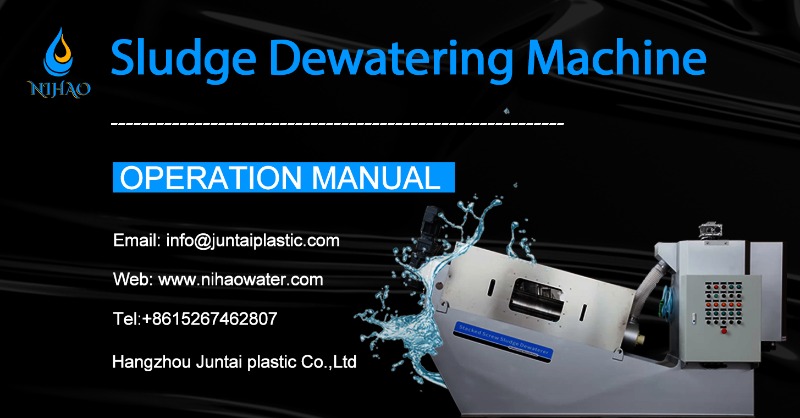
1. Pre-Start Inspection
1) Inspect the equipment for any severe deformation or extensive damage to the paint (minor abrasions during transportation are normal).
2) Check if there are any foreign objects in the mixing tank(sludge water will be coagulation in this tank, and we also call it a coagulation tank), whether the filter body has emptied the sludge, and whether there are any mud blocks at the head of the spiral shaft.
2. Preparation
1) Ensure that the equipment's pipeline connections are correct and that it operates normally after being powered on.
2) Prepare the dosing system and the necessary chemicals for the equipment, which is typically PAM cationic, with a molecular weight of 8000-10000. (PS: The usual default is 2-5kg of powder added to 1000L of water, diluted and stirred for 60 minutes. The specific amount may vary depending on the site conditions, and the data is for reference only.)
1) Power on the machine and start the main motor and mixer, observe the direction of rotation of the main motor to ensure that it is correct;
2) Start the coagulant dosing pump, sludge feeding pump, and coagulation mixing motor in sequence;
3) Adjust the sludge feeding and dosing amount to ensure that the sludge coagulation particles are larger than the size of soybeans, and that the mud and water are separated (refer to Figure 1 and Figure 2);
4) Use the frequency converter to adjust the speed of the entire spiral shaft (range: 30-50, refer to Figure 3), and adjust the spacing of the End Plate by tightening the mud pressure plate screw (refer to Figure 4) to achieve the best processing volume and moisture content.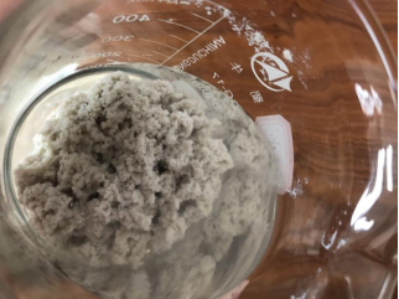
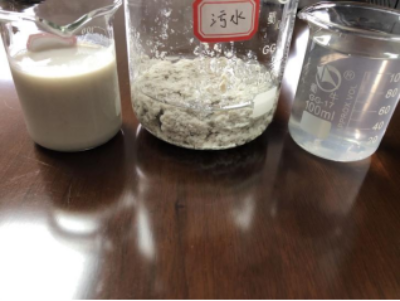
Figure 1 Figure 2
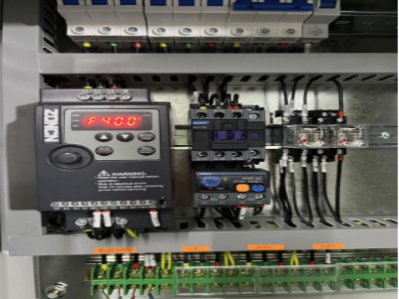
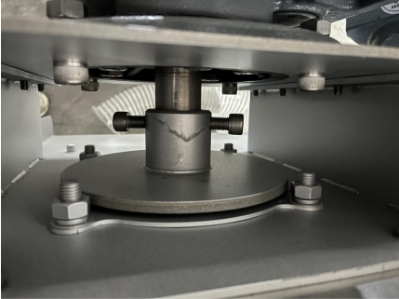
Figure 3 Figure 4
4. Post-Startup Inspection
1) Turn off the sludge feed pump to stop the sludge feeding;
2) Turn off the coagulant dosing pump and the dosing system to stop dosing;
3) Drain the mixing tank and stop the coagulation mixing motor;
4) Wait for all the sludge to be discharged (no less than 30 minutes), manually spray the filter
5) Turn off the power supply.
1) Set a reasonable start-stop time for automatic operation, and complete the entire process as required;
2) Adjust the "flow control tube" to the appropriate height according to different sludge concentrations;
3) Overloading of sludge is strictly prohibited to prevent sludge from accumulating in the thickening section of the dewatering machine due to excessive sludge;
4) Large slag, wood, metal blocks, and other hard solids are strictly prohibited from flowing into the sludge pump and filter of the dewatering machine;
5) When manually cleaning, do not pour water onto electrical components such as motors and control boxes;
6) Regularly replace or add gear lubricating oil to the reducer(once every three months);
7) Check whether the nuts at various locations such as the filter body are loose regularly (once a month);
8) Conduct maintenance every three months.
Daily Inspection Items
|
Inspection locations |
Inspection items |
Check |
|
Electric Motor |
Is the motor running normally? |
□ |
|
Are there any abnormal noises? |
□ |
|
|
Is there any vibration? |
□ |
|
|
End Plate |
Is the gap set appropriately? |
□ |
|
Is the change in moisture content of the dewatered sludge too large? |
□ |
|
|
Screw Press Body |
Whether the solid content of the filtrate is abnormal? |
□ |
|
Measuring Tank |
Is there any sludge piled around the reflux pipe and weir? |
□ |
|
Mixing Tank |
Is there any sludge accumulated around the flow tube and electrode? |
□ |
|
Has an appropriate Alum flower formed? |
□ |
Regular Inspection Items
|
Inspection locations |
Inspection items |
Check |
|
Electrical Control Cabinet |
Are all the indicator lights lighting up normally? |
□ |
|
Electric Motor |
Whether there is abnormal heating? |
□ |
|
Whether there is oil leakage? |
□ |
|
|
Whether the current value is similar to normal? |
□ |
|
|
Timer |
Is it running according to the set value? |
□ |
|
Variable Frequency Drive (VFD) |
Is it operating according to the set values? |
□ |
|
Is there any abnormal heat? |
□ |
|
|
Are the display screen and LEDs lighting up normally? |
□ |
|
|
Screw Press Body |
Whether the movable ring is in motion? |
□ |
|
Whether there is a large amount of filtrate leaking between the rings? |
□ |
|
|
Solenoid Valve |
Is it operating? |
□ |
|
Can it switch normally? |
□ |
|
|
Is it leaking water? |
□ |
|
|
Measuring Tank |
Has the inflow rate changed? |
□ |
|
Bolts and Nuts |
Are they loose? |
□ |
|
Piping and Valve |
Are they loose? |
□ |
|
Whether it is broken or damaged? |
□ |
Handling abnormal situations
|
Location of Exception |
Exception Content |
Possible Reasons |
Corresponding Measures |
|
Electric Control Cabine |
Light is not on |
The bulb has exceeded its service life |
Replace the bulb |
|
Electric Motor |
Not running |
Overload |
Contact our company or agency |
|
The motor itself is faulty |
Replace the Motor |
||
|
Poor contact |
Check the line |
||
|
Abnormal heating |
Overload |
Reduce the load |
|
|
The motor is faulty |
Replace the Motor |
||
|
Voltage too high (low) |
Check the voltage |
||
|
Abnormal noise |
The motor is faulty |
Replace the Motor |
|
|
Foreign matter mixed in at the impeller |
Clear foreign matter or replace the motor |
||
|
Vibration |
Bolt is loose |
Tighten the Bolts |
|
|
Motor is faulty |
Replace the motor |
||
|
Oil leakage |
Motor is faulty |
Replace the motor |
|
|
Timer |
Not running |
Poor contact |
Check the line |
|
Not running according to the set value |
Timer failure |
Replace the Timer |
|
|
Frequency Converter |
Not running according to the set value |
The setting method is incorrect |
Please refer to the frequency converter manual |
|
Abnormal heating |
Start and stop too frequently |
Please refer to the frequency converter manual |
|
|
Voltage too high (low) |
Please refer to the frequency converter manual |
||
|
Vibration |
Fixed bolt is loose |
Tighten |
|
|
Frequency converter failure |
Replace the frequency converter |
||
|
The display screen and LED lights are not on |
Poor contact |
Check the line |
|
|
Frequency converter failure |
Replace the frequency converter |
||
|
End Plate |
Not adjusted to a suitable gap |
Fixed bolts is loose |
Adjust to a suitable gap and then tighten the bolt |
|
The change in moisture content of the sludge cake is too large |
The sludge characteristics have changed |
Please refer to the manual. |
|
|
Screw Press Body |
The spindle is blocked |
The spindle is blocked by sludge |
Reverse operation will guide the sludge out |
|
Too much sludge leakage from the filter seam |
No suitable alum flower has been formed |
Please refer to the manual |
|
|
Too much sludge input |
Reduce the sludge input through the liquid level regulating tube |
||
|
The rotation speed of the screw shaft is too slow |
Increase the rotation speed of the screw shaft |
||
|
The solid content of the filtered liquid is too high |
No suitable alum flower has been formed |
Please refer to the manual |
|
|
Too much sludge input |
Reduce the sludge input through the liquid level regulating tube |
||
|
The rotation speed of the screw shaft is too slow |
Increase the rotation speed of the screw shaft |
||
|
Solenoid Valve |
Not running |
Poor wiring |
Check the line |
|
Foreign matter mixed in |
Clear foreign matter |
||
|
Gate is closed |
Open the passage |
||
|
Cannot fully switch |
Foreign matter mixed in |
Clear foreign matter |
|
|
Solenoid Valve failure |
Replace the Solenoid Valve |
||
|
Leakage |
Foreign matter mixed in |
Clear foreign matter |
|
|
Measuring Tank |
Sludge accumulates around the reflux pipe and weir |
-- |
Clear accumulated sludge |
|
Mixing Tank |
Sludge accumulates on the laminar flow pipe or electrode |
-- |
Clear accumulated sludge |
|
Bolts and Nuts |
Loose |
-- |
Tighten |
|
Piping and Valve |
Loose |
-- |
Tighten |
|
Rupture or damage |
-- |
Replace the damaged part. |
Precautions For Long-term Downtime